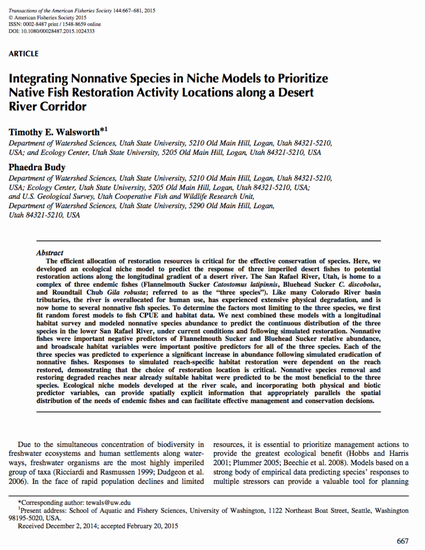
Article
Integrating Nonnative Species in Niche Models to Prioritize Native Fish Restoration Activity Locations along a Desert River Corridor
Transactions of the American Fisheries Society
(2015)
Abstract
The efficient allocation of restoration resources is critical for the effective conservation of species. Here, we developed an ecological niche model to predict the response of three imperiled desert fishes to potential restoration actions along the longitudinal gradient of a desert river. The San Rafael River, Utah, is home to a complex of three endemic fishes (Flannelmouth Sucker Catostomus latipinnis, Bluehead Sucker C. discobolus, and Roundtail Chub Gila robusta; referred to as the “three species”). Like many Colorado River basin tributaries, the river is overallocated for human use, has experienced extensive physical degradation, and is now home to several nonnative fish species. To determine the factors most limiting to the three species, we first fit random forest models to fish CPUE and habitat data. We next combined these models with a longitudinal habitat survey and modeled nonnative species abundance to predict the continuous distribution of the three species in the lower San Rafael River, under current conditions and following simulated restoration. Nonnative fishes were important negative predictors of Flannelmouth Sucker and Bluehead Sucker relative abundance, and broadscale habitat variables were important positive predictors for all of the three species.
Disciplines
Publication Date
2015
DOI
http://dx.doi.org/10.1080/00028487.2015.1024333
Citation Information
Walsworth, TE and Budy, P. 2015. Integrating Nonnative Species in Niche Models to Prioritize Native Fish Restoration Activity Locations along a Desert River Corridor. Transactions of the American Fisheries Society 144(4):667-681. http://dx.doi.org/10.1080/00028487.2015.1024333
